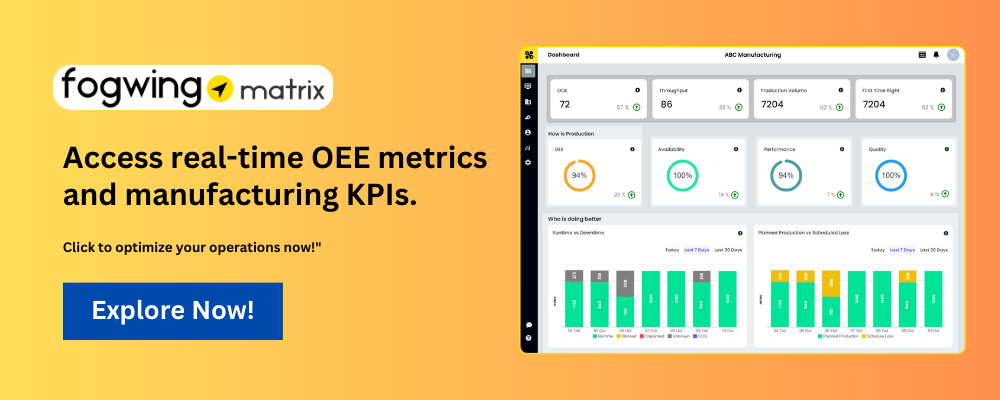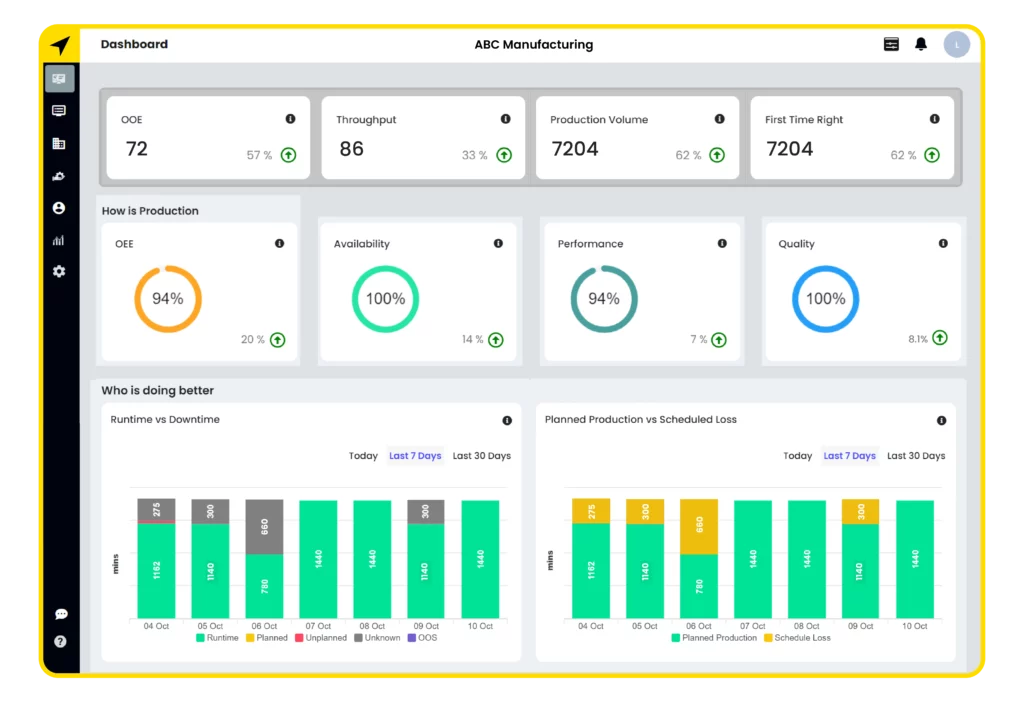In today’s fast-paced world, ensuring optimal productivity and efficiency is the key to staying ahead. This is where Overall Equipment Effectiveness enters the scene as a powerful metric that can revolutionize your approach to manufacturing. Join us as we explore how it enables organizations to measure equipment performance and drive continuous improvement, ultimately delivering exceptional quality products and gaining a significant edge in their industry. So, buckle up for an insightful journey into understanding why Overall Equipment Effectiveness should be at the heart of every forward-thinking company committed to achieving total quality excellence.
Introduction to Overall Equipment Effectiveness and Total Quality Management
In today’s highly competitive manufacturing landscape, businesses constantly strive to improve their production processes and increase efficiency. Two key methodologies that have emerged as crucial for achieving these goals are Overall Equipment Effectiveness and Total Quality Management. These two concepts work hand in hand to drive a culture of continuous improvement and overall excellence in a company’s operations.
What is OEE?
It is a metric that evaluates how effectively machines or equipment are utilized in production processes. It considers three production process components – Availability, Performance, and quality – to provide a holistic view of equipment effectiveness.
Availability refers to when equipment is available for production without downtime or unplanned stops. Performance measures the speed at which equipment operates compared to its potential speed, considering factors such as minor stoppages and idling time. Quality evaluates the number of good units produced compared to the total units produced.
By analyzing these three components, manufacturing can identify areas where their equipment is underperforming or encountering issues, leading to bottlenecks in the production flow. It can also track improvements over time by setting benchmarks and monitoring progress toward meeting them.
Total Quality Management (TQM):
TQM is a management approach focused on continuous improvement through involvement from all levels of an organization. TQM emphasizes a customer-centric approach to quality, where all processes and activities are geared towards meeting customer requirements and expectations. It also involves empowering employees to actively participate in improving processes, identifying and solving problems, and continuously striving for excellence.
Total Quality Management follows the principle that quality is everyone’s responsibility, from top management to front-line workers. By embracing TQM principles, companies can foster a culture of continuous improvement, resulting in increased efficiency and higher-quality products.

Some benefits of using OEE in TQM include:
- Enhanced Process Visibility: It provides a panoramic view of equipment performance, offering invaluable insights for decision-makers seeking to enhance their product quality. The ability to pinpoint bottlenecks and inefficiencies fosters a proactive approach to quality improvement initiatives.
- Reduced Defect Rates: By addressing performance and quality aspects, OEE is a vigilant guardian against defects, ensuring that each product rolling off the production line meets or exceeds stringent quality standards. Real-world examples showcase organizations that have successfully minimized defect rates by effectively implementing OEE in a TQM context.
- Optimized Production Schedules: OEE’s contribution extends to meticulous scheduling, as it aids in identifying and resolving issues that might disrupt production timelines. This optimization ensures that market demands are met without compromising the high-quality standards set by TQM. Case studies featuring companies successfully navigating production scheduling challenges through Overall Equipment Effectiveness implementation offer actionable insights.
Factors that Affect OEE

Overall Equipment Effectiveness is a crucial metric that measures the Performance and efficiency of production equipment. It is used to determine how well a machine or system is performing compared to its maximum potential. It is based on three factors – Availability, Performance, and quality – to calculate the overall efficiency of the equipment.
This section will explain the factors that can affect OEE and how they impact overall production quality and efficiency.
- Equipment breakdowns and downtime: Equipment breakdowns can significantly impact OEE as they directly affect Availability. When machines break down or malfunction, they cannot perform their intended function, resulting in downtime. It lowers the availability of equipment and ultimately reduces its overall equipment effectiveness.
- Setup and changeover time: Another factor affecting OEE is setup and changeover time between different products or processes. Longer setup times mean more idle time for equipment, reducing Availability and directly impacting OEE.
- Speed losses: Performance refers to how well the equipment performs compared to its theoretical maximum speed. Factors like wear and tear over time, inadequate maintenance, or incorrect operation can result in slower running speeds and reduced performance levels.
- Quality defects: The third component is quality output; it measures the percentage of products produced without any defects or rework required. High-quality standards are critical for maintaining high-performance levels without slowing down production due to issues such as rework or scrap caused by poor quality.
- Operator inefficiencies: The skills and proficiency of machine operators also play a crucial role in the OEE calculation. Lack of training or experience leads to operator errors, causing downtime, quality defects, and slower performance speeds.
- Material shortages and delays: A lack of critical materials or delays in the supply chain can adversely affect OEE. Due to insufficient raw materials, equipment may not run at total capacity, leading to lower Availability and reduced production output.
- Maintenance schedules and breakdowns: Regular maintenance is essential for keeping equipment running efficiently. Failure to adhere to scheduled maintenance can result in unexpected equipment breakdowns that lead to unplanned downtime, reducing OEE.
- Workforce management: The number of employees available during shifts can also impact it. Understaffing during busy periods can cause bottlenecks that affect Availability and performance, resulting in lower overall equipment effectiveness.
- Environmental factors: External factors such as extreme temperatures or weather conditions can affect the performance of machines and equipment. High humidity or excessive heat/cold can cause breakdowns or slow production rates, impacting OEE.
OEE Calculation: Formula and Examples
Now that we have a deeper understanding of Overall Equipment Effectiveness and its importance in Total Quality Management let’s delve into how it is calculated. OEE is a performance metric that provides insight into the efficiency and effectiveness of equipment in a manufacturing facility. It considers three key factors – Availability, Performance, and quality – to determine the overall equipment effectiveness score.
OEE = Availability x Performance x Quality
Each factor has its own equation that contributes to the final OEE score. Let’s break them down further:
1. Availability: This factor measures the time equipment is available for production. The formula for Availability is:
Availability = Operating Time / Planned Production Time
Operating time refers to the total time during which the machine was intended to run. In contrast, planned production time refers to the total operating time minus any planned downtimes (e.g., scheduled maintenance). The result is expressed as a percentage.
2. Performance: This factor considers how efficiently the equipment runs compared to its maximum output potential. The formula for Performance is:
Performance = Actual Output / Maximum Possible Output
Actual output refers to the total number of units produced during a specific period, while maximum possible output represents what could have been produced if there were no stoppages or slowdowns due to operational inefficiencies such as minor breakdowns or reduced speed due to setup or alignment issues. The result is expressed as a percentage.
3. Quality: This factor measures the number of units produced that meet the quality standards set by the company. The quality formula is:
Quality = Good Units / Total Units Produced
Good units refer to products that meet all quality specifications, while total units produced include both good and defective products. Similar to Availability and Performance, the result is expressed as a percentage.
To get a detailed calculation of Overall Equipment Effectiveness , click here How To Calculate OEE Of Machine | Fogwing.io
Examples of Calculating Overall Equipment Effectiveness
Let’s look at two examples to further illustrate how Overall Equipment Effectiveness is calculated in real-life scenarios.
Example 1:
A manufacturing plant operates 24 hours daily with scheduled maintenance every weekend from Saturday 6 pm to Sunday 6 am. For one week, it produces 5,000 units, of which only 4,200 are considered good units based on quality standards. The maximum possible output for this plant during this period was calculated to be 7,500 units, considering no stoppages or slowdowns due to operational inefficiencies.
Using the formula mentioned above:
– Operating Time = (7 days x 24 hours) – (1 downtime event x 12 hours)
= (168 hours) – (12 hours)
= 156 hours
– Planned Production Time = (7 days x 24 hours) – (1 scheduled maintenance event x 12 hours)
= (168 hours) – (12 hours)
= 156 hours
Now, using the three factors, Overall Equipment Effectiveness for this plant can be calculated as:
– Availability = Operating Time / Planned Production Time
= 156 / 168
= 0.93 or 93%
– Performance = Actual Output / Maximum Possible Output
= 5,000 / 7,500
= 0.67 or 67%
– Quality = Good Units / Total Units Produced
= 4,200 / 5,000
= 0.84 or 84%
Therefore, the OEE for this plant during this week can be calculated as:
Overall Equipment Effectiveness = Availability x Performance x Quality
= (0.93) x (0.67) x (0.84)
= 0.53 or 53%
Best Practices for Improving OEE in TQM
Total Quality Management (TQM) is a top-notch management approach that emphasizes continuous improvement and achieving high levels of quality across all aspects of an organization. When it comes to manufacturing, one key factor in TQM is Overall Equipment Effectiveness. It measures the Performance of equipment in terms of its Availability, Performance, and quality. In this section, we will discuss some best practices for improving Overall Equipment Effectiveness within the framework of TQM.
- Identify and Address Root Causes of Equipment Downtime:
The first step towards improving Overall Equipment Effectiveness in TQM is identifying the root causes of equipment downtime. This involves analyzing historical data and conducting thorough inspections to determine the reasons for machine breakdowns or failures. Once these root causes are identified, they can be addressed through proper maintenance strategies such as preventive maintenance schedules, timely repairs, and operator training programs.
- Implement Total Productive Maintenance (TPM):
TPM is a proactive maintenance approach that aims to maximize equipment efficiency by involving all employees, from operators to top-level management. With TPM, operators take ownership of their machines by conducting regular checks, cleaning and lubricating equipment, and identifying early signs of wear or damage. This reduces downtime, improves overall equipment performance, and extends its lifespan.
- Set Realistic Performance Goals:
Setting realistic goals for each piece of equipment based on its capabilities can significantly improve Overall Equipment Effectiveness in TQM. It’s essential to involve all stakeholders in this process so that everyone understands the importance of achieving these goals and can work towards them together. Realistic goals can motivate employees, reduce downtime, and improve overall equipment performance.
- Track and Analyze OEE Data:
Consistently tracking and analyzing Overall Equipment Effectiveness data is crucial in identifying areas for improvement in TQM. This data can help identify which machines are underperforming or experiencing frequent breakdowns, allowing for targeted improvement efforts. With this data, you can also measure the effectiveness of improvements, or any changes made to the equipment.
- Eliminate Waste:
In TQM, eliminating waste is a key principle in achieving high-quality production. One significant type of waste that affects Overall Equipment Effectiveness is unplanned downtime caused by factors such as faulty equipment, missing materials, or changing production schedules. By implementing the lean manufacturing principles and continuous improvement processes, you can identify and eliminate waste within your operations to improve Overall Equipment Effectiveness.
- Empower Employees:
Empowering employees with proper training and resources can significantly impact Overall Equipment Effectiveness in TQM. Properly trained employees are more likely to operate equipment efficiently and detect minor issues before they become significant problems that cause downtime.
Common Challenges and Solutions in Implementing OEE in TQM
Implementing Overall Equipment Effectiveness as a part of Total Quality Management (TQM) can significantly benefit any organization. However, like any undertaking, there are challenges that may arise along the way. This section will explore some common challenges organizations face when implementing Overall Equipment Effectiveness in TQM and discuss possible solutions.
1. Resistance to change:
One of the most common challenges faced by companies is resistance to change. Employees may feel overwhelmed or threatened by the introduction of new processes and technology associated with implementing Overall Equipment Effectiveness in TQM. This leads to a lack of enthusiasm and motivation among employees.
Solution:
To overcome the challenge, it is crucial to involve workforces from all levels of the organization during the planning process for implementing Overall Equipment Effectiveness in TQM. This will help them understand the need for change and get their buy-in. Additionally, providing proper training and support throughout the implementation process can help alleviate employees’ fears or concerns.
2. Lack of data accuracy:
Another challenge that organizations face is obtaining accurate data for calculating OEE-metrics. Inaccurate or incomplete data leads to misleading results and hinders decision-making based on its measurements.
Solution:
Investing in an efficient system for tracking equipment performance is crucial to ensure accurate data collection. This could include using software with real-time monitoring capabilities or implementing automated data collection methods such as sensors or barcode scanners.

Fogwing Matrix for improving OEE in TQM
Fogwing Matrix is an IoT (Internet of Things) based solution that offers a range of features to improve Overall Equipment Effectiveness to achieve Total Quality Management (TQM) in manufacturing. Fogwing matrix machine monitoring allows manufacturers to collect real-time data through sensors to monitor the various parameters of production operations. It plays a crucial role in monitoring Overall Equipment Effectiveness by providing real-time visibility into multiple aspects of the manufacturing process. Here’s how Fogwing Matrix can enhance Overall Equipment Effectiveness in achieving TQM.
Performance Metrics: Fogwing Matrix is a production monitoring software that meticulously captures and computes key performance indicators associated with Availability, Performance, and Quality—the three integral components of Overall Equipment Effectiveness. These metrics encompass:
Availability: This involves meticulous tracking of machine uptime and downtime, providing insights into the reasons for downtime, such as maintenance activities, changeovers, or unexpected breakdowns.
Performance: The software closely observes production rates and efficiency, shedding light on factors like speed losses, idle periods, or minor stoppages that may impact overall Performance.
Quality: A vigilant tracking of quality metrics is conducted, identifying defects, scrap, and instances requiring rework in the production process.
Data Representation and Dashboards: Fogwing Matrix proficiently presents this wealth of information through a comprehensible and user-friendly dashboard, facilitating a visually intuitive understanding of the production landscape.
Data Analysis: Fogwing Matrix solution analyses historical data, enabling businesses to see trends and patterns in OEE metrics over time. This analysis helps identify recurring issues and plan for improvements.
Perpetual Improvement: Fogwing Matrix actively supports continuous enhancement endeavors by furnishing practical insights. Manufacturers can utilize the accumulated data to fine-tune processes, diminish downtime, elevate product quality, and bolster overall operational efficiency.
Harnessing Automation for Efficiency: Businesses can capitalize on Fogwing’s highly automated and cost-efficient Overall Equipment Effectiveness capabilities to streamline operations, mitigate downtime, enhance product quality, and optimize resource utilization. This strategic approach culminates in substantially improving Total Quality Management (TQM).
Conclusion:
Overall Equipment Effectiveness plays a crucial role in implementing Total Quality Management (TQM) in an organization. It is a powerful tool that allows companies to identify and discard inefficiencies in their production processes, leading to improved productivity, reduced costs, and, ultimately, better quality products.
Through the three main components of Overall Equipment Effectiveness – Availability, Performance, and quality – organizations can measure their equipment’s overall effectiveness and determine improvement areas. Companies can continuously monitor and analyze these metrics to pinpoint specific issues and implement targeted solutions to enhance their overall equipment effectiveness.
To know more about how to improve OEE, read this, 5 Ways To Improve OEE In Manufacturing Operations | Fogwing.io





